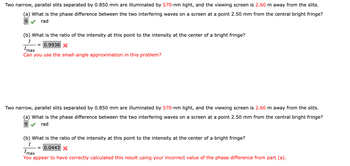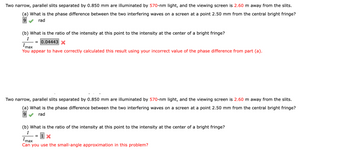
College Physics
11th Edition
ISBN: 9781305952300
Author: Raymond A. Serway, Chris Vuille
Publisher: Cengage Learning
expand_more
expand_more
format_list_bulleted
Concept explainers
Question

Transcribed Image Text:Two narrow, parallel slits separated by 0.850 mm are illuminated by 570-nm light, and the viewing screen is 2.60 m away from the slits.
(a) What is the phase difference between the two interfering waves on a screen at a point 2.50 mm from the central bright fringe?
9
rad
(b) What is the ratio of the intensity at this point to the intensity at the center of a bright fringe?
I
= 0.9938 X
Imax
Can you use the small-angle approximation in this problem?
Two narrow, parallel slits separated by 0.850 mm are illuminated by 570-nm light, and the viewing screen is 2.60 m away from the slits.
(a) What is the phase difference between the two interfering waves on a screen at a point 2.50 mm from the central bright fringe?
9 rad
(b) What is the ratio of the intensity at this point to the intensity at the center of a bright fringe?
I
= 0.0443 X
Imax
You appear to have correctly calculated this result using your incorrect value of the phase difference from part (a).

Transcribed Image Text:Two narrow, parallel slits separated by 0.850 mm are illuminated by 570-nm light, and the viewing screen is 2.60 m away from the slits.
(a) What is the phase difference between the two interfering waves on a screen at a point 2.50 mm from the central bright fringe?
9 rad
Imax
You appear to have correctly calculated this result using your incorrect value of the phase difference from part (a).
(b) What is the ratio of the intensity at this point to the intensity at the center of a bright fringe?
I
= 0.04443 X
Two narrow, parallel slits separated by 0.850 mm are illuminated by 570-nm light, and the viewing screen is 2.60 m away from the slits.
(a) What is the phase difference between the two interfering waves on a screen at a point 2.50 mm from the central bright fringe?
9
rad
(b) What is the ratio of the intensity at this point to the intensity at the center of a bright fringe?
I
=
1 X
Imax
Can you use the small-angle approximation in this problem?
Expert Solution
This question has been solved!
Explore an expertly crafted, step-by-step solution for a thorough understanding of key concepts.
Step by stepSolved in 3 steps with 3 images

Knowledge Booster
Learn more about
Need a deep-dive on the concept behind this application? Look no further. Learn more about this topic, physics and related others by exploring similar questions and additional content below.Similar questions
- Question A2 Red light of vacuum wavelength 650 nm is travelling in a non-magnetic dielectric glass of refrac- tive index ng = 1.60. Calculate the impedance of the glass, the wavelength of light in the glass, and the critical angle 0c for total internal reflection at a glass-air interface. Question A3 Light is incident from air onto a horizontal surface of water of refractive index nw = 1.33. Calculate the Brewster angle at which the reflectance for the TM polarisation is zero. Also, cal- culate the power reflection coefficient RTE for TE-polarised light incident at this Brewster angle.arrow_forwardA double-slit arrangement produces interference fringes that have an angular separation of 5.14 × 10-3 rad for light with a wavelength of A = 429 nm. For what wavelength would the angular separation be 14.6% greater? Number i Unitsarrow_forwardDear pro Hand written solution is not allowed.arrow_forward
- Find the largest wavelength (in nm) of light falling on double slits separated by 7.5o µm for which there is a second-order maximum. nm Is this in the visible part of the spectrum? Yes Noarrow_forward1. (a) What is the highest-order maximum for 400 -nm light falling on double slits separated by 25 µm? Hint: Is there a limit on how many bright and dark bands appear on a pattern? (b) What part of the EM spectrum does this wavelength belong to? Visible Region/Ultraviolet O Infrared X-raysarrow_forwardThe figure below shows a radio wave transmitter and a receiver separated by a distance d = 50distance d = 50, 0 m, both being at a height h = 35, 0 m above the ground. The receiver canThe receiver can receive signals either directly or indirectly from reflected signals on the ground. Suppose that theground is leveled and a 180o phase shift occurs in the reflection.Determine the longest wavelengths that interferea. constructively;b. destructively.arrow_forward
- 0 The following questions refer to the following pattern obtained from a double-slit interference experiment. E is the center of the pattern. A B CD E F G H Fringe is a first order maximum. MAY SHIZA 2 a. G Ob. H OC. F Od. 1 ů QUESTION 5 281 O 5 tvarrow_forwardLight with a Wave length 09 1=6alonm is ashone 4irst on a single Mit Awidth W=1-25Mm. The sing le slit Is then replaced with a douple slit separated by adıstance w. ne fatio 07 the single Slitanale to the doubie slit ang le 4DY Yhe 7iKrt dark 7ringe is Ro. A=16210nm W=1.25um nnd the rati0 between these angles numerIcally.arrow_forwardIn a double-slit experiment, d 21um and the wavelength of the light is A = 431nm. The intensity of light at the center of the central fringe is measured to be 21 kW -. Determine the intensity at a point that is at an angle of 1.4° from m? the center of the central fringe lin HW m?). (Use the ideal double slit intensity formula)arrow_forward
arrow_back_ios
arrow_forward_ios
Recommended textbooks for you
 College PhysicsPhysicsISBN:9781305952300Author:Raymond A. Serway, Chris VuillePublisher:Cengage Learning
College PhysicsPhysicsISBN:9781305952300Author:Raymond A. Serway, Chris VuillePublisher:Cengage Learning University Physics (14th Edition)PhysicsISBN:9780133969290Author:Hugh D. Young, Roger A. FreedmanPublisher:PEARSON
University Physics (14th Edition)PhysicsISBN:9780133969290Author:Hugh D. Young, Roger A. FreedmanPublisher:PEARSON Introduction To Quantum MechanicsPhysicsISBN:9781107189638Author:Griffiths, David J., Schroeter, Darrell F.Publisher:Cambridge University Press
Introduction To Quantum MechanicsPhysicsISBN:9781107189638Author:Griffiths, David J., Schroeter, Darrell F.Publisher:Cambridge University Press Physics for Scientists and EngineersPhysicsISBN:9781337553278Author:Raymond A. Serway, John W. JewettPublisher:Cengage Learning
Physics for Scientists and EngineersPhysicsISBN:9781337553278Author:Raymond A. Serway, John W. JewettPublisher:Cengage Learning Lecture- Tutorials for Introductory AstronomyPhysicsISBN:9780321820464Author:Edward E. Prather, Tim P. Slater, Jeff P. Adams, Gina BrissendenPublisher:Addison-Wesley
Lecture- Tutorials for Introductory AstronomyPhysicsISBN:9780321820464Author:Edward E. Prather, Tim P. Slater, Jeff P. Adams, Gina BrissendenPublisher:Addison-Wesley College Physics: A Strategic Approach (4th Editio...PhysicsISBN:9780134609034Author:Randall D. Knight (Professor Emeritus), Brian Jones, Stuart FieldPublisher:PEARSON
College Physics: A Strategic Approach (4th Editio...PhysicsISBN:9780134609034Author:Randall D. Knight (Professor Emeritus), Brian Jones, Stuart FieldPublisher:PEARSON

College Physics
Physics
ISBN:9781305952300
Author:Raymond A. Serway, Chris Vuille
Publisher:Cengage Learning

University Physics (14th Edition)
Physics
ISBN:9780133969290
Author:Hugh D. Young, Roger A. Freedman
Publisher:PEARSON

Introduction To Quantum Mechanics
Physics
ISBN:9781107189638
Author:Griffiths, David J., Schroeter, Darrell F.
Publisher:Cambridge University Press

Physics for Scientists and Engineers
Physics
ISBN:9781337553278
Author:Raymond A. Serway, John W. Jewett
Publisher:Cengage Learning

Lecture- Tutorials for Introductory Astronomy
Physics
ISBN:9780321820464
Author:Edward E. Prather, Tim P. Slater, Jeff P. Adams, Gina Brissenden
Publisher:Addison-Wesley

College Physics: A Strategic Approach (4th Editio...
Physics
ISBN:9780134609034
Author:Randall D. Knight (Professor Emeritus), Brian Jones, Stuart Field
Publisher:PEARSON